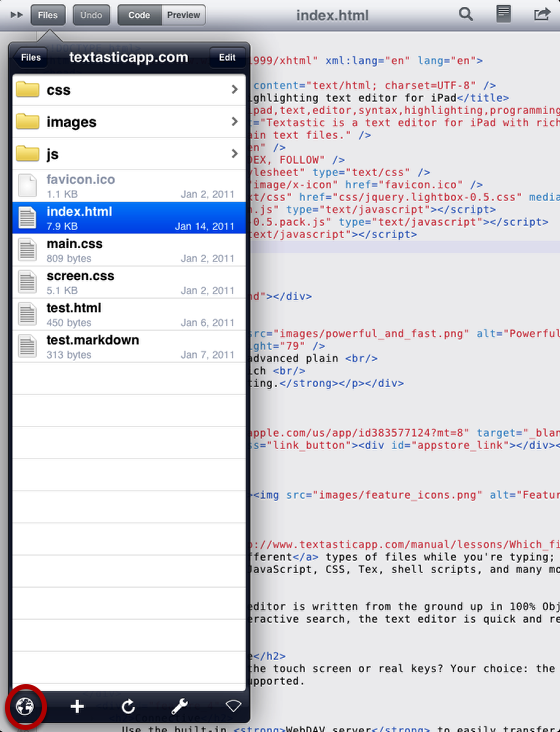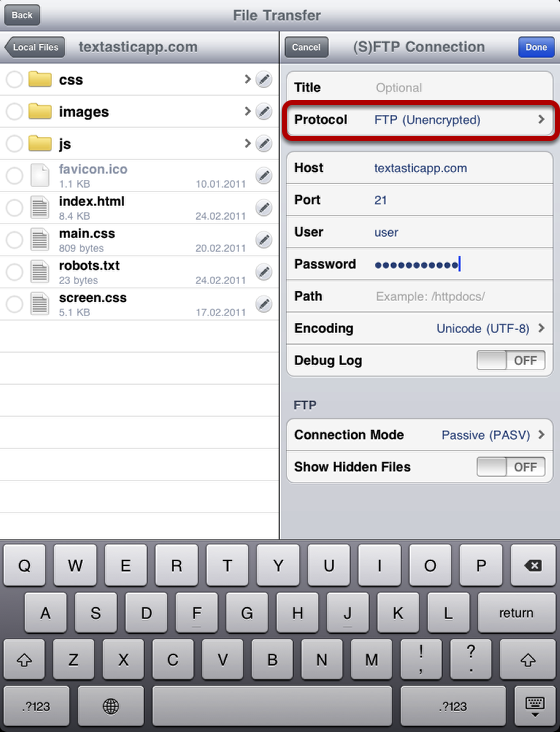How do I connect to an FTP, FTPS or SFTP server?
Learn how to configure a new FTP, FTPS (FTP over SSL) or SFTP (SSH File Transfer Protocol) connection.
Open the File Transfer Screen

Tap on the File Transfer button in the Files section to open the File Transfer screen.
Add an (S)FTP Connection

Tap on the + button (1) and choose (S)FTP Connection (2) to add a new connection.
Configure an FTP (Unencrypted) Connection

Choose the "FTP (Unencrypted)" protocol.
Configure the connection by setting the host name (this can be a domain name like "example.com" or an ip address), a user name and a password.
You can also add a custom title that will appear in the connection list and choose another port than the standard port 21.
If you enter a path, Textastic will use this as the root path when connecting to the server.
Choose the correct character encoding you want to use for this connection. This setting depends on your server's configuration.
If you encounter connection problems with the standard "Passive (PASV)" connection mode, try to use "Active (PORT)" instead.
Enable the Show Hidden Files setting if you want to see hidden remote files like ".htaccess".
You can also try to enable the Debug Log setting. This will create detailed log files in the "logs" directory in Textastic. Note that this logs all traffic for this connection, so only enable this for debugging purposes and make sure to disable it again as soon as possible.
Configure an FTPS (FTP over SSL) Connection

For FTPS / FTP over SSL connections, most settings are the same as for regular FTP connections (see above). Notice the different default port 990.
FTPS adds an option that allows you to choose if Textastic verifies the SSL certificate of the server. Disable this if you use a self-signed certificate on the server.
Configure an SFTP (SSH) Connection

SFTP (SSH File Transfer Protocol) is a subsystem of SSH (Secure Shell). You can use this connection type to securely transfer files between your server and Textastic. For more information have a look at SSH File Transfer Protocl (Wikipedia)
The default port for SFTP connections is 22.
Textastic usually switches to the root directory after establishing an SFTP connection. If you want to start at the user's home directory instead, enter "~/" in the Path field.
Textastic supports user/password authentication as well as public key authentication.
1. User/Password authentication
Enter your user name and password as you would for a regular FTP connection, but disable the Public Key Auth. setting.
2. Public Key Authentication
Enter the user name.
Enable the Public Key Auth. setting. Now you can enter the path to the private key file.
For this to work, you need to transfer the private key file for your SSH account to Textastic. You can do this by using iTunes File Sharing (via USB), Dropbox or the built-in WebDAV server (via Wi-Fi).
The standard settings expect a private key file named "id_rsa" in the "ssh" subfolder in Textastic (see screenshot). If you used iTunes File Sharing, the file will be in the root folder, so you can either enter "id_rsa" as the private key file path or move the file to a subfolder.
If your private key file is protected with a passphrase, Textastic uses the password setting to retrieve the private key.
Textastic expects the key file to be in the format used by the OpenSSH utility "ssh-keygen". If you instead have a key in PuTTY's format (.ppk), you can use PuTTYgen to convert it to OpenSSH format:
Visit the PuTTY website and download puttygen.exe (on your PC). Open it, and using the File menu, load your .ppk that you already use, and type in your passphrase. Now go to the Conversions menu and export the key as an OpenSSH key. You can now use the converted key with Textastic.
If you encounter connection problems, you can enable the Debug Log setting. This will create detailed log files in the "logs" directory in Textastic. Note that this logs all traffic for this connection, so only enable this for debugging purposes and make sure to disable it again as soon as possible.
Save Connection

Tap Done to save this connection.
Connect

You can now tap on the newly created connection to connect to the remote server.